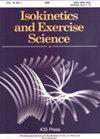Influence of toe flexor muscle fatigue on stiffness of the intrinsic foot muscles
IF 0.7
4区 医学
Q4 ENGINEERING, BIOMEDICAL
引用次数: 0
Abstract
BACKGROUND: Assessing intrinsic foot muscles (IFM) is important for understanding their role in loading movements. Additionally, knowledge of the impact of IFM following toe flexor muscle fatigue may aid the teaching of IFM exercises. OBJECTIVE: To examine the influence of toe flexor muscle fatigueon IFM stiffness using ultrasound shear-wave elastography. METHODS: This study included 19 college students. IFM stiffness at 10%, 50%, and 90% body weight was measured using ultrasound-based shear-wave elastography. IFM including the abductor hallucis (AbH), flexor hallucis brevis (FHB), flexor digitorum brevis (FDB), and quadratus plantae (QP) were assessed. The fatigue induction protocol comprised a series of toe flexions at a controlled pace of 40 beats per minute and an amplitude of 75% of the maximum toe flexor strength for a duration of 5 minutes. RESULTS: Muscle stiffness significantly increased with increasing load. Toe flexor muscle fatigue significantly increased the stiffness of the FDB. CONCLUSIONS: IFM stiffness significantly increased with increasing load, and the stiffness of FDB significantly increased in the toe flexor muscle fatigue condition at DLS and SLS loads. The findings of this study will contribute to the study and clinical setting of IFM exercises.脚趾屈肌疲劳对足部内在肌肉僵硬度的影响
背景:评估足部内在肌肉(IFM)对于了解它们在负重运动中的作用非常重要。此外,了解足趾屈肌疲劳后对足内肌的影响有助于足内肌锻炼的教学。目的:使用超声剪切波弹性成像技术研究趾屈肌疲劳对 IFM 硬度的影响。方法:本研究包括 19 名大学生。使用超声剪切波弹性成像技术测量了体重为 10%、50% 和 90% 时的 IFM 硬度。对包括拇外展肌 (AbH)、拇弯肌 (FHB)、趾弯肌 (FDB) 和股四头肌 (QP) 在内的 IFM 进行了评估。疲劳诱导方案包括一系列脚趾屈伸动作,速度控制在每分钟 40 次,幅度为脚趾屈伸肌最大力量的 75%,持续时间为 5 分钟。结果:随着负荷的增加,肌肉僵硬度明显增加。趾屈肌疲劳会明显增加 FDB 的僵硬度。结论:在 DLS 和 SLS 负荷下,随着负荷的增加,IFM 硬度明显增加,而在趾屈肌疲劳状态下,FDB 的硬度也明显增加。本研究结果将有助于 IFM 锻炼的研究和临床应用。
本文章由计算机程序翻译,如有差异,请以英文原文为准。
求助全文
约1分钟内获得全文
求助全文
来源期刊

Isokinetics and Exercise Science
医学-工程:生物医学
CiteScore
1.20
自引率
14.30%
发文量
37
审稿时长
>12 weeks
期刊介绍:
Isokinetics and Exercise Science (IES) is an international journal devoted to the study of theoretical and applied aspects of human muscle performance. Since isokinetic dynamometry constitutes the major tool in this area, the journal takes a particular interest in exploring the considerable potential of this technology.
IES publishes studies associated with the methodology of muscle performance especially with respect to the issues of reproducibility and validity of testing, description of normal and pathological mechanical parameters which are derivable from muscle testing, applications in basic research topics such as motor learning paradigms and electromyography. The journal also publishes studies on applications in clinical settings and technical aspects of the various measurement systems employed in human muscle performance research.
The journal welcomes submissions in the form of research papers, reviews, case studies and technical reports from professionals in the fields of sports medicine, orthopaedic and neurological rehabilitation and exercise physiology.
 求助内容:
求助内容: 应助结果提醒方式:
应助结果提醒方式:


